Like a painter’s palette bursting with year-round color, indoor flowering plants can transform your living space into a perpetual garden. You’ll discover that growing these blooming beauties isn’t just about adding visual appeal – it’s about creating a living ecosystem within your four walls. From the elegant Peace Lily‘s white spathes to the Kalanchoe‘s jewel-toned clusters, each plant brings its own personality and care requirements to your indoor garden. Let’s explore which varieties will best suit your space and lifestyle.
Contents
1. Peace Lily
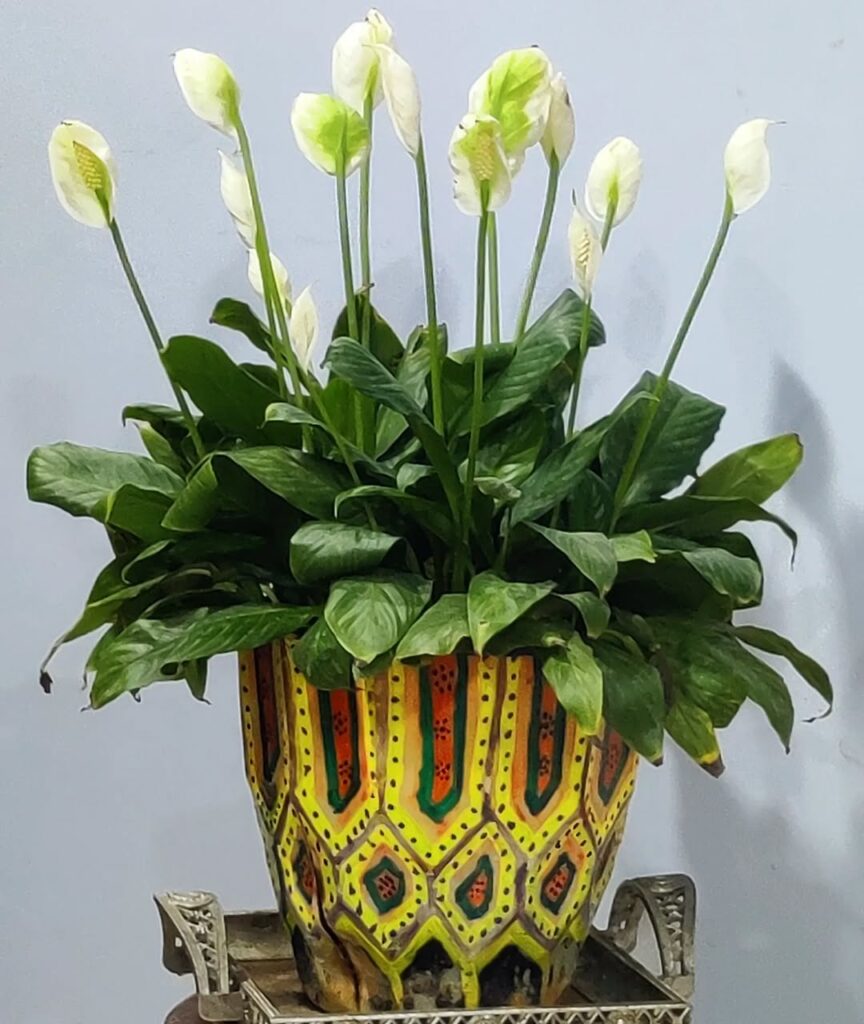
Peace lily blooms are elegant white flowers that emerge from deep green foliage throughout the year. The distinctive spoon-shaped flowers, technically called spathes, rise above the leaves on long stems and can last for several weeks. These blooms start out pale green, gradually turning pure white as they mature, and they may appear multiple times per year when growing conditions are ideal.
- Light: Bright indirect light; tolerates low light but may not bloom as frequently; avoid direct sunlight
- Water: Keep soil consistently moist but not waterlogged; water when top inch of soil feels dry
- Soil: Well-draining potting mix rich in organic matter
- Humidity: Prefers high humidity; mist leaves regularly or use a humidity tray
- Temperature: 65-80°F (18-27°C)
- Fertilizer: Feed monthly with balanced liquid fertilizer during growing season
- Pot: Container with good drainage holes
2. Kalanchoe
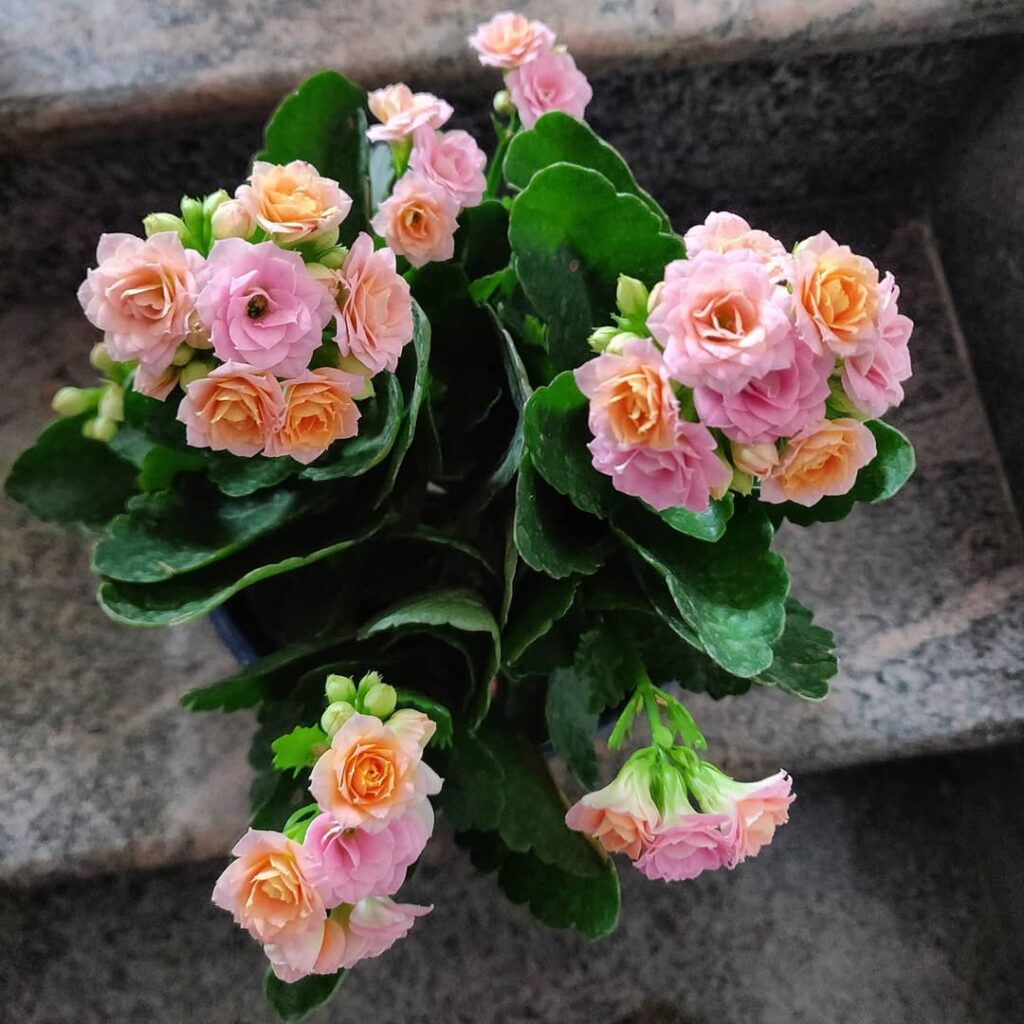
Kalanchoe blossfeldiana, commonly known as Flaming Katy, produces clusters of small, vibrant flowers in shades of red, orange, pink, yellow, and white that bloom for several weeks at a time. These succulent plants feature thick, dark green leaves and can reach heights of 8-12 inches, making them perfect for indoor windowsills or tabletop displays. With proper care, kalanchoes can rebloom multiple times throughout the year, providing long-lasting indoor color.
- Light: Bright, indirect sunlight; protect from intense afternoon sun; needs 14 hours of darkness daily for 6 weeks to trigger reblooming
- Water: Allow soil to dry between waterings; reduce watering in winter; avoid getting water on leaves
- Soil: Well-draining potting mix formulated for succulents
- Temperature: 60-85°F (15-29°C); protect from cold drafts
- Humidity: Tolerates average indoor humidity levels
- Fertilizer: Feed monthly with balanced liquid fertilizer during growing season
- Pruning: Remove spent blooms and leggy growth to encourage bushiness
3. African Violet
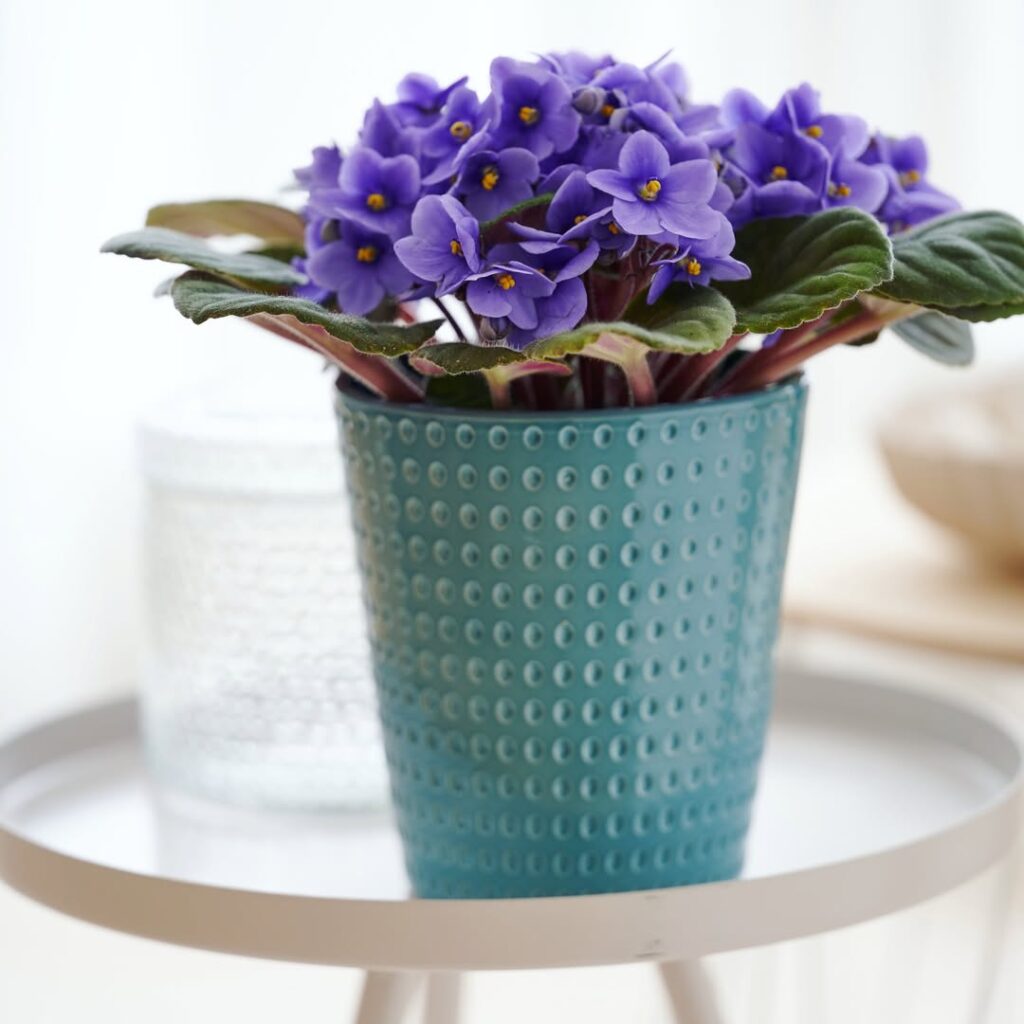
African Violets produce charming clusters of delicate flowers in shades of purple, pink, blue, and white, nestled among dark green, fuzzy leaves. These compact plants typically grow 6-8 inches tall and wide, with blooms appearing in small groups above the foliage throughout the year when properly maintained. The velvety, heart-shaped leaves form a symmetrical rosette pattern, and the five-petaled flowers can be single, double, or ruffled, creating an elegant display suitable for windowsills and small spaces.
- Light: Bright, indirect light; avoid direct sunlight; 12-14 hours of artificial light if natural light is insufficient
- Water: Keep soil consistently moist but not wet; water from bottom to avoid leaf damage; use room temperature water
- Soil: Light, well-draining African Violet potting mix with high organic content
- Temperature: 65-75°F (18-24°C)
- Humidity: 40-60%; use humidity tray if needed
- Fertilizer: Balanced, water-soluble fertilizer specifically for African Violets every 2-4 weeks
- Container: Small pot with drainage holes; repot when root-bound
4. Star Jasmine
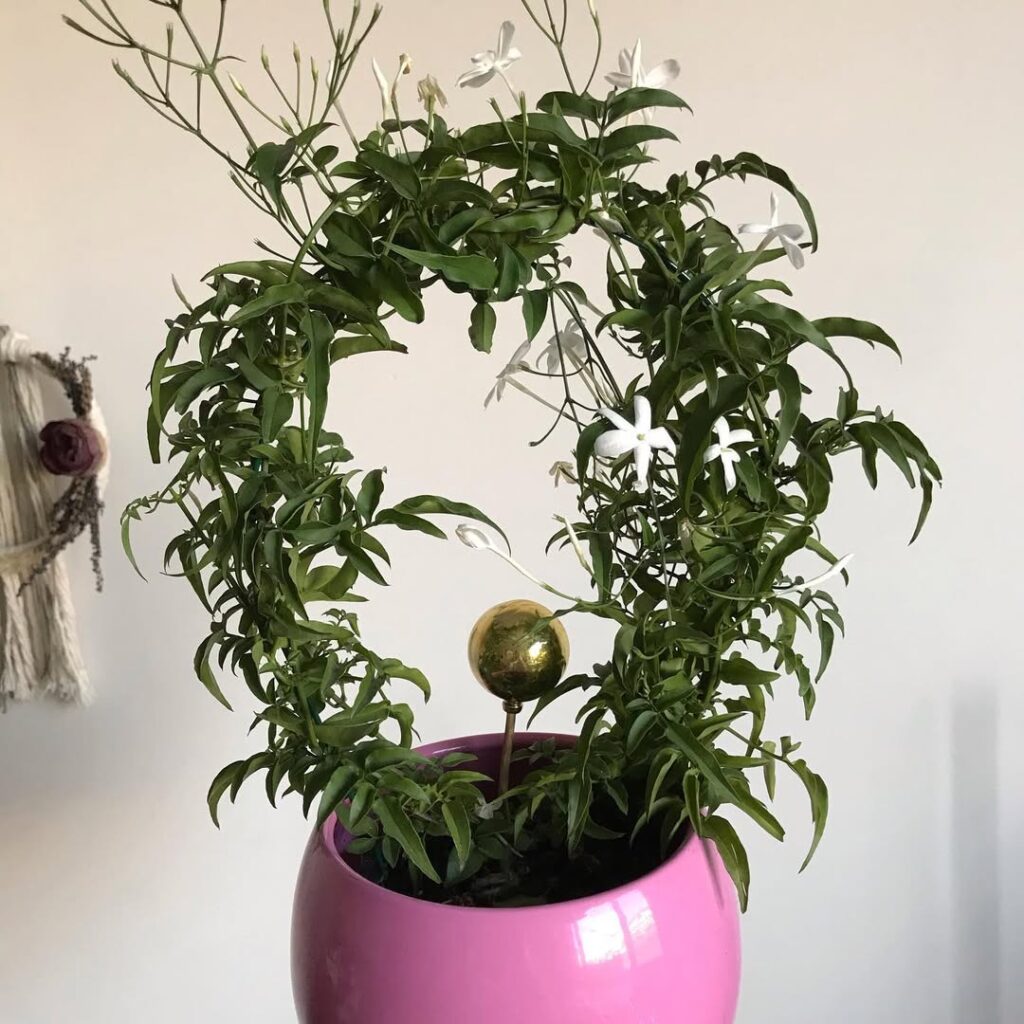
Star jasmine, known for its delicate white pinwheel-shaped flowers, produces an intense sweet fragrance that can fill an entire room. As a beloved indoor climbing plant, it blooms prolifically from late spring through early fall, with some varieties flowering sporadically throughout the year. The glossy dark green foliage provides an attractive backdrop for the clusters of star-shaped blossoms, making it an excellent choice for trellises, hanging baskets, or as a trailing houseplant.
- Light: Bright, indirect sunlight; morning sun is beneficial, but protect from harsh afternoon rays
- Water: Keep soil consistently moist but not waterlogged; reduce watering in winter
- Soil: Well-draining, rich potting mix with added organic matter
- Humidity: Moderate to high; regular misting or humidity tray recommended
- Temperature: 60-75°F (15-24°C); protect from cold drafts
- Fertilizer: Feed monthly during growing season with balanced liquid fertilizer
- Pruning: Trim after flowering to maintain shape and encourage bushier growth
- Support: Provide trellis or stakes for climbing varieties
5. Crown of Thorns
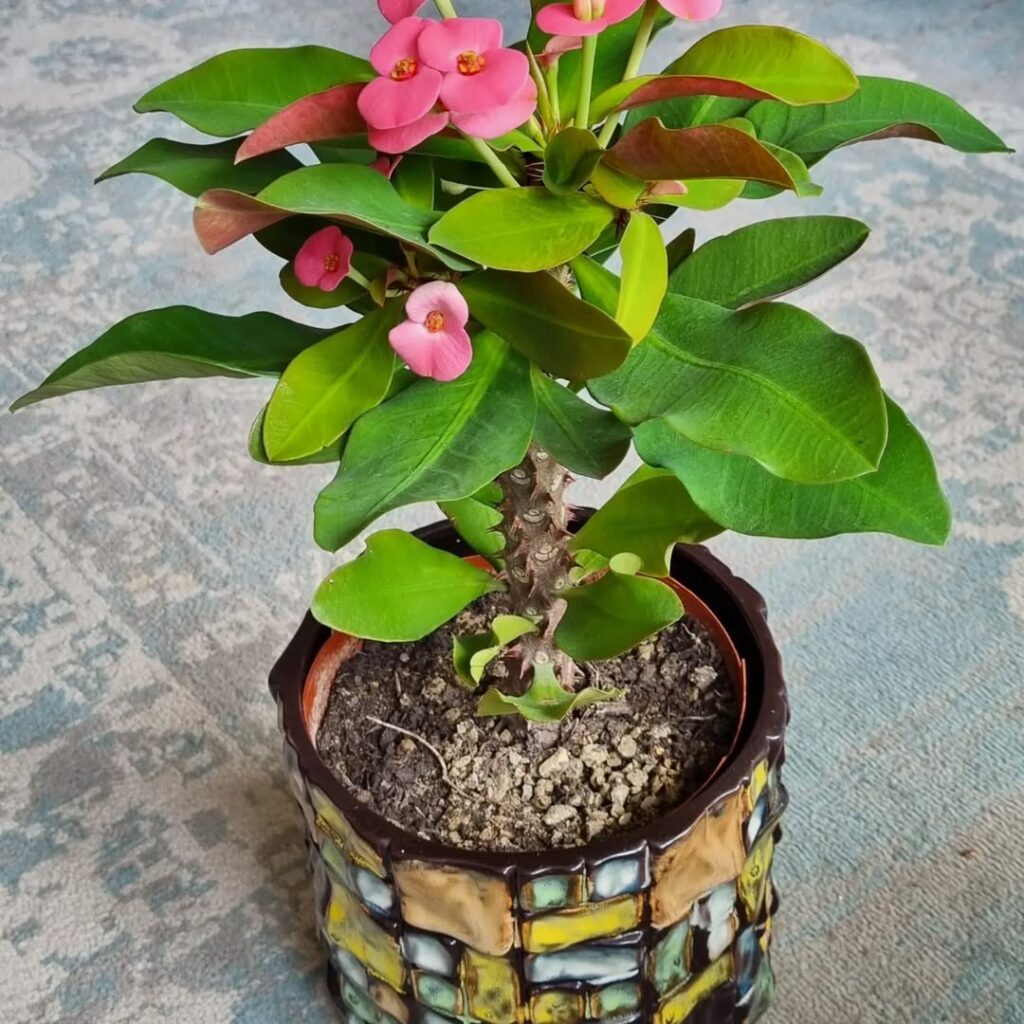
Crown of Thorns (Euphorbia milii) is a long-blooming succulent that produces clusters of small, colorful flowers surrounded by showy bracts throughout the year. Native to Madagascar, this hardy plant features thick, spiny stems and oval-shaped leaves, making it both decorative and defensive. The flowers commonly appear in red, pink, or white, though hybrid varieties offer additional color options. When properly cared for, Crown of Thorns can bloom continuously indoors, making it an excellent choice for year-round color.
- Light: Bright, direct sunlight for at least 4-6 hours daily; can tolerate some partial shade
- Water: Allow soil to dry between waterings; reduce watering in winter
- Soil: Well-draining cactus or succulent mix
- Temperature: 65-75°F (18-24°C); can tolerate brief periods of cooler temperatures
- Humidity: Tolerates average indoor humidity levels
- Fertilizer: Feed monthly during growing season with balanced, water-soluble fertilizer
- Container: Pot with drainage holes; terracotta preferred
- Pruning: Remove dead or damaged stems as needed; wear gloves due to thorns and toxic sap
6. Cyclamen
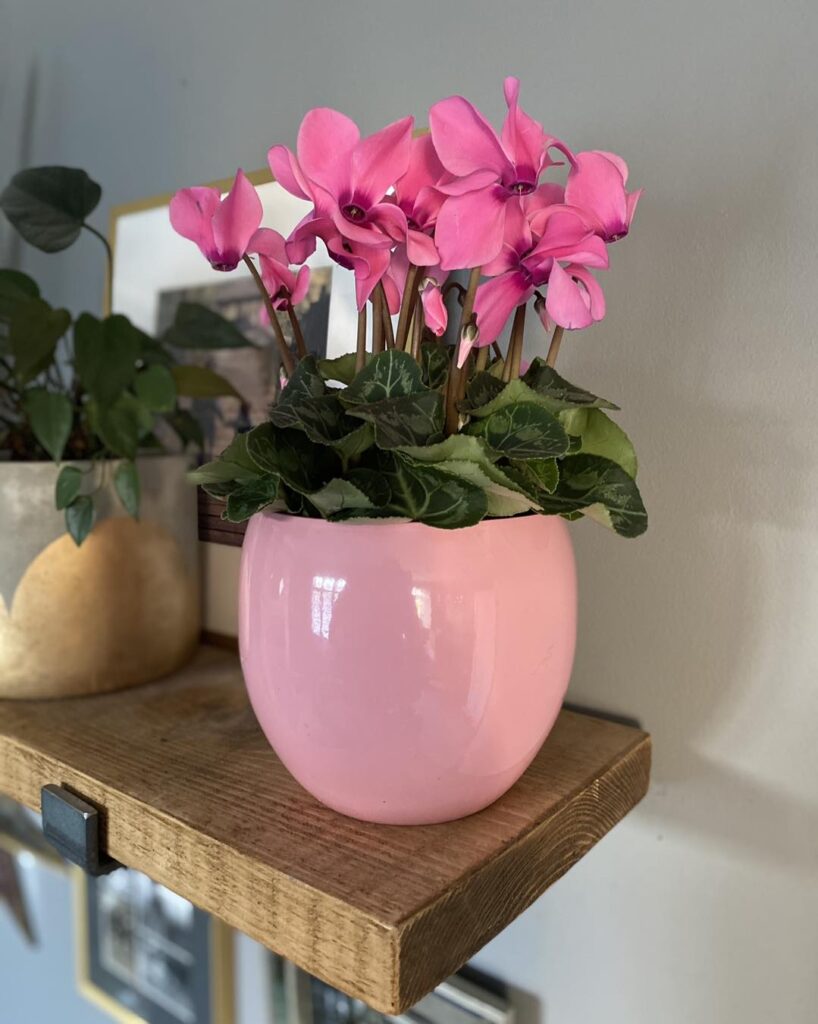
Cyclamen plants produce delicate pink butterfly-like blooms that hover above heart-shaped, silver-marbled foliage. These elegant flowers feature upswept petals in various shades of pink, from soft pastel to deep rose, creating a graceful display that can last for several months when properly maintained. The compact nature and extended blooming period of pink cyclamen make them excellent choices for indoor decoration, particularly during winter months when other plants are dormant.
- Light: Bright, indirect sunlight; avoid direct sun which can damage leaves
- Water: Keep soil lightly moist but not wet; water from bottom to prevent crown rot
- Soil: Well-draining potting mix rich in organic matter
- Temperature: Cool conditions between 60-65°F (15-18°C)
- Humidity: Moderate to high; use pebble tray or mist regularly
- Fertilizer: Feed monthly with balanced liquid fertilizer during growing season
- Repotting: Annually after dormancy, using fresh potting mix
- Dormancy: Reduce watering when leaves yellow; resume care when new growth appears
7. Red Heart Anthurium
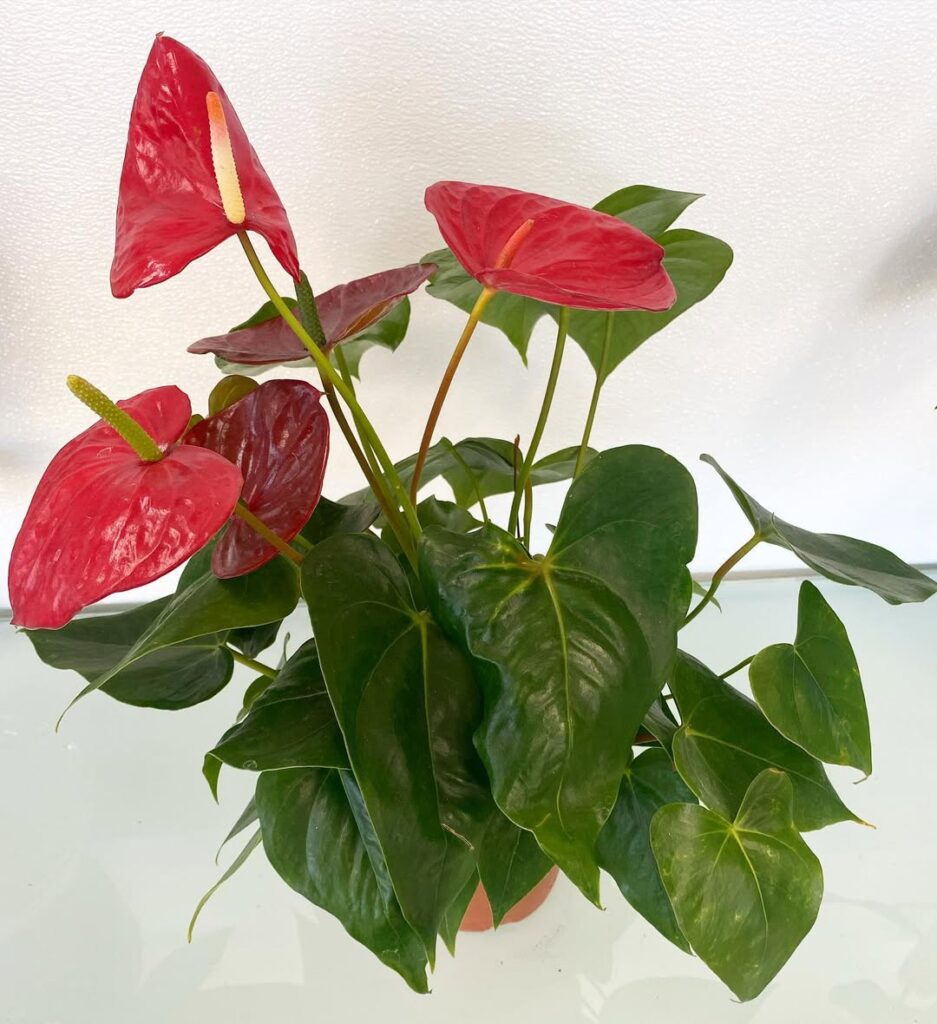
Anthurium Red Hearts, also known as Flamingo Flowers, are striking tropical plants recognized for their glossy, heart-shaped red flowers that aren’t actually flowers at all, but modified leaves called spathes. The true flowers are tiny and grow on the protruding spadix in the center of each spathe. These long-lasting blooms can persist for several months, making them excellent indoor plants that provide continuous color throughout the year when properly maintained.
- Light: Bright, indirect light; avoid direct sunlight which can scorch leaves
- Water: Keep soil consistently moist but not waterlogged; water when top inch of soil feels dry
- Humidity: High humidity (60-80%); regular misting or use of humidity tray recommended
- Temperature: 70-85°F (21-29°C); protect from cold drafts
- Soil: Well-draining, organic potting mix rich in peat moss
- Fertilizer: Feed monthly during growing season with balanced, phosphorus-rich fertilizer
- Container: Pot with adequate drainage holes
- pH: 5.5-6.5 (slightly acidic)
8. Poinsettia
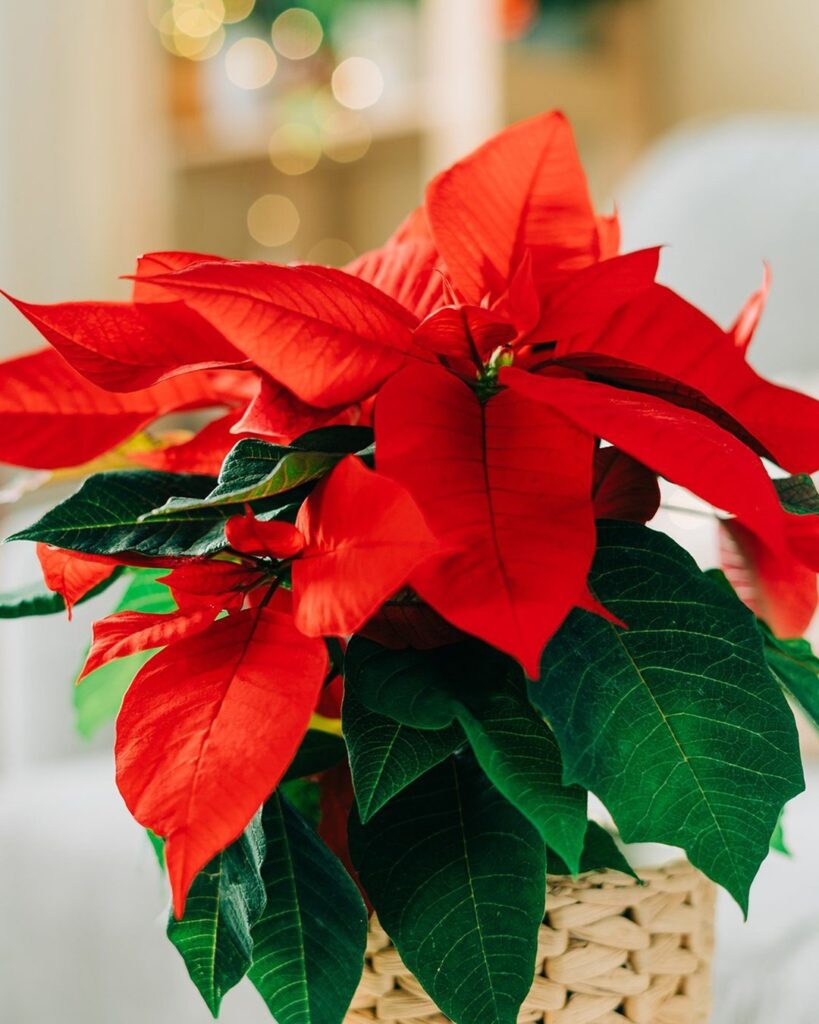
Poinsettia’s vibrant red bracts, often mistaken for flowers, create a stunning indoor display that can last for several months with proper care. While traditionally associated with winter holidays, these tropical plants can maintain their colorful display well beyond the season when given ideal conditions. The true flowers are actually the small yellow clusters in the center of the colored bracts.
- Light: Bright, indirect sunlight for 6-8 hours daily; protect from hot afternoon sun
- Water: Keep soil moderately moist but never soggy; water when top inch feels dry
- Soil: Well-draining potting mix rich in organic matter with pH 5.5-6.5
- Temperature: 65-75°F (18-24°C); protect from cold drafts
- Humidity: 50-70%; mist leaves regularly or use a humidity tray
- Fertilizer: Monthly feeding with balanced fertilizer during growing season
- Pruning: Cut back stems by one-third in spring to promote bushier growth
9. Amaryllis
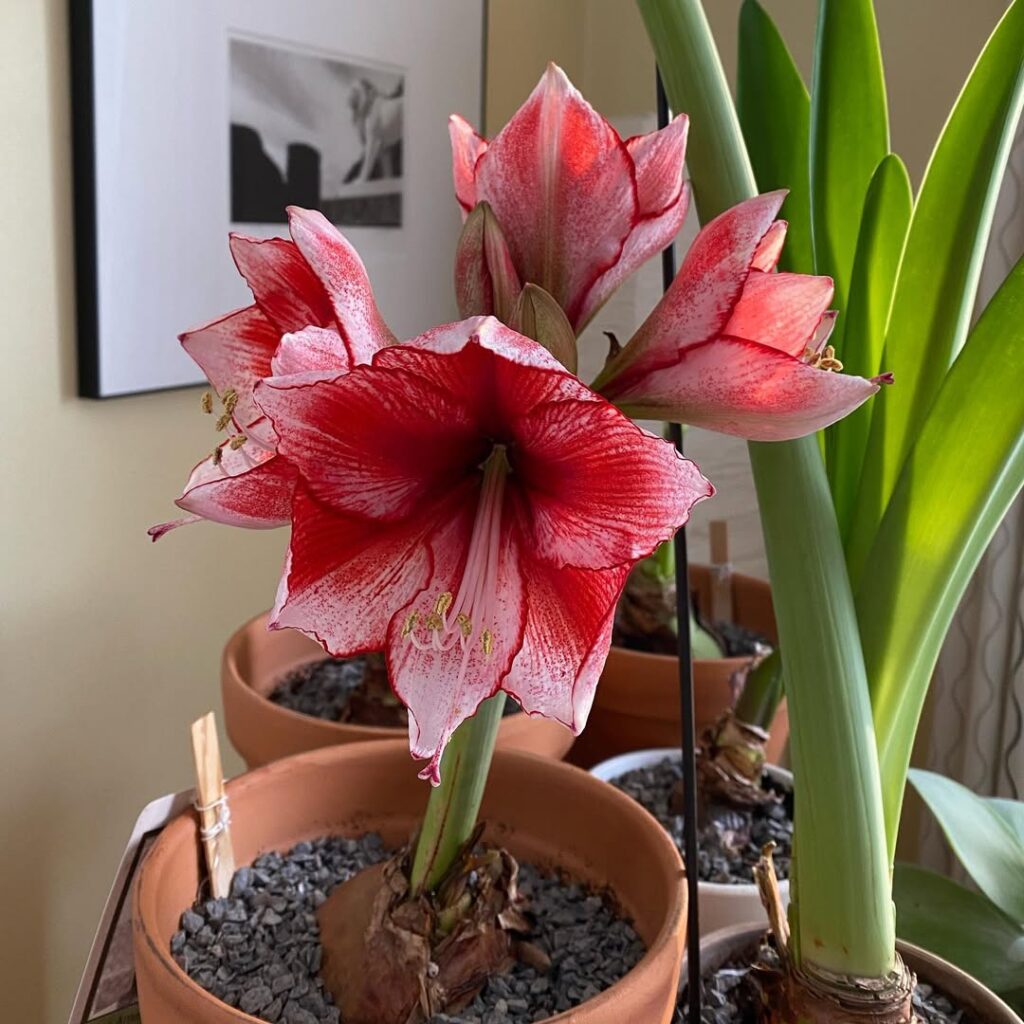
The Amaryllis is a striking winter bloomer that produces large, trumpet-shaped flowers in vibrant shades of red, pink, white, or salmon atop tall, sturdy stalks. Popular during the holiday season, these bulbous plants can be forced to bloom indoors between December and March, creating spectacular displays that last for several weeks. With proper care and timing, amaryllis bulbs can be preserved after blooming and coaxed to flower again the following winter season.
- Light: Bright indirect sunlight; during growing season, place in sunny window but protect from intense afternoon sun
- Water: Keep soil evenly moist but not waterlogged during growing season; reduce watering when plant enters dormancy
- Soil: Well-draining potting mix with added perlite or sand
- Temperature: 70-75°F (21-24°C) during growth; 55-60°F (13-16°C) during dormancy
- Humidity: Average household humidity levels (40-50%)
- Container: Heavy pot with drainage holes, slightly larger than bulb
- Fertilizer: Balanced water-soluble fertilizer every 2-3 weeks during growing season
- Depth: Plant with top third of bulb exposed above soil surface
10. Lipstick Plant
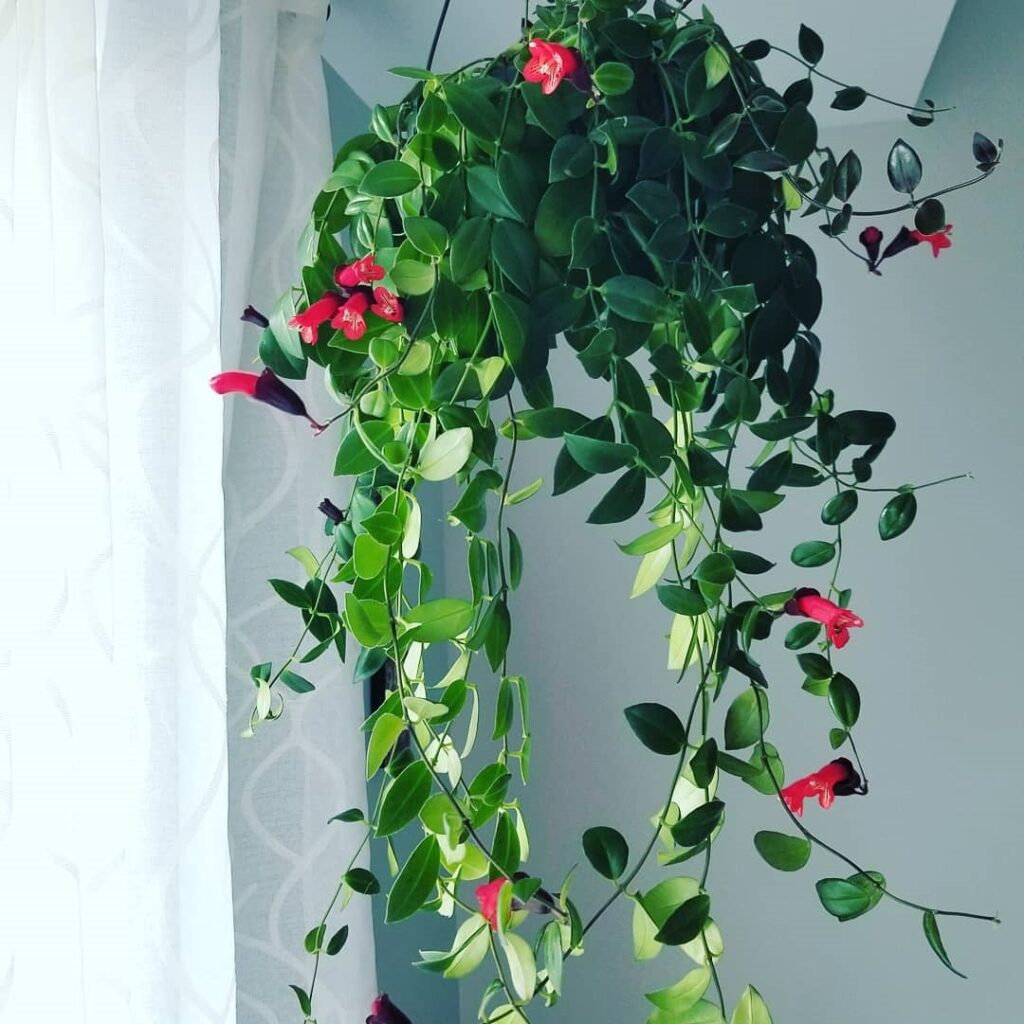
The Trailing Lipstick Plant (Aeschynanthus radicans) is a striking tropical vine known for its vibrant red tubular flowers that resemble tubes of lipstick emerging from dark purple-black buds. This epiphytic plant cascades beautifully from hanging baskets or elevated pots, with its glossy green leaves growing along trailing stems that can reach several feet in length. When properly cared for, it produces multiple blooming cycles throughout the year, making it an excellent choice for adding continuous color to indoor spaces.
- Light: Bright, indirect light; protect from direct afternoon sun; can tolerate moderate shade
- Water: Keep soil consistently moist but not waterlogged; reduce watering in winter
- Humidity: High humidity (60-80%); benefits from regular misting or humidity tray
- Temperature: 65-80°F (18-27°C); protect from cold drafts
- Soil: Well-draining, organic potting mix; orchid mix or African violet soil works well
- Fertilizer: Feed monthly with balanced, water-soluble fertilizer during growing season
- Container: Use hanging baskets or elevated pots with good drainage
- pH: Slightly acidic to neutral (6.0-7.0)
11. Moth Orchid
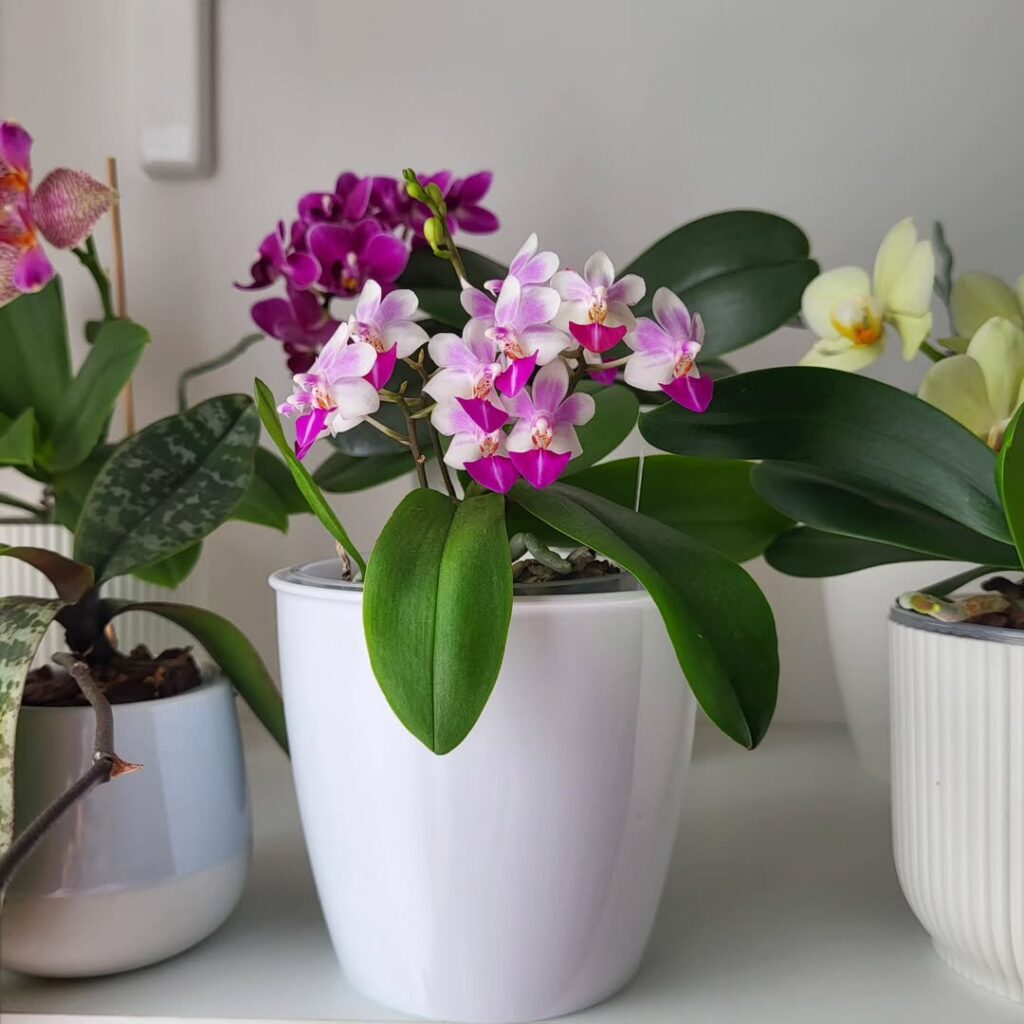
The Phalaenopsis orchid, commonly known as the moth orchid, produces striking butterfly-like blooms that can last for several months at a time. These elegant flowers come in a variety of colors including white, pink, purple, and yellow, often featuring intricate patterns and spots. The long-lasting blooms grow on graceful arching stems, with each plant capable of producing multiple flower spikes throughout the year when properly cared for.
- Light: Bright indirect sunlight; avoid direct sun which can burn leaves
- Temperature: 65-80°F (18-27°C); night temperatures slightly cooler
- Humidity: 50-70%; use humidity trays or room humidifiers
- Water: Water thoroughly when potting medium feels dry; avoid wet roots
- Soil: Well-draining orchid mix containing bark, perlite, and sphagnum moss
- Fertilizer: Balanced orchid fertilizer every 2-4 weeks during growing season
- Container: Use pots with drainage holes; plastic or clay orchid pots preferred
- Repotting: Every 1-2 years when media breaks down or roots outgrow pot
12. Begonia
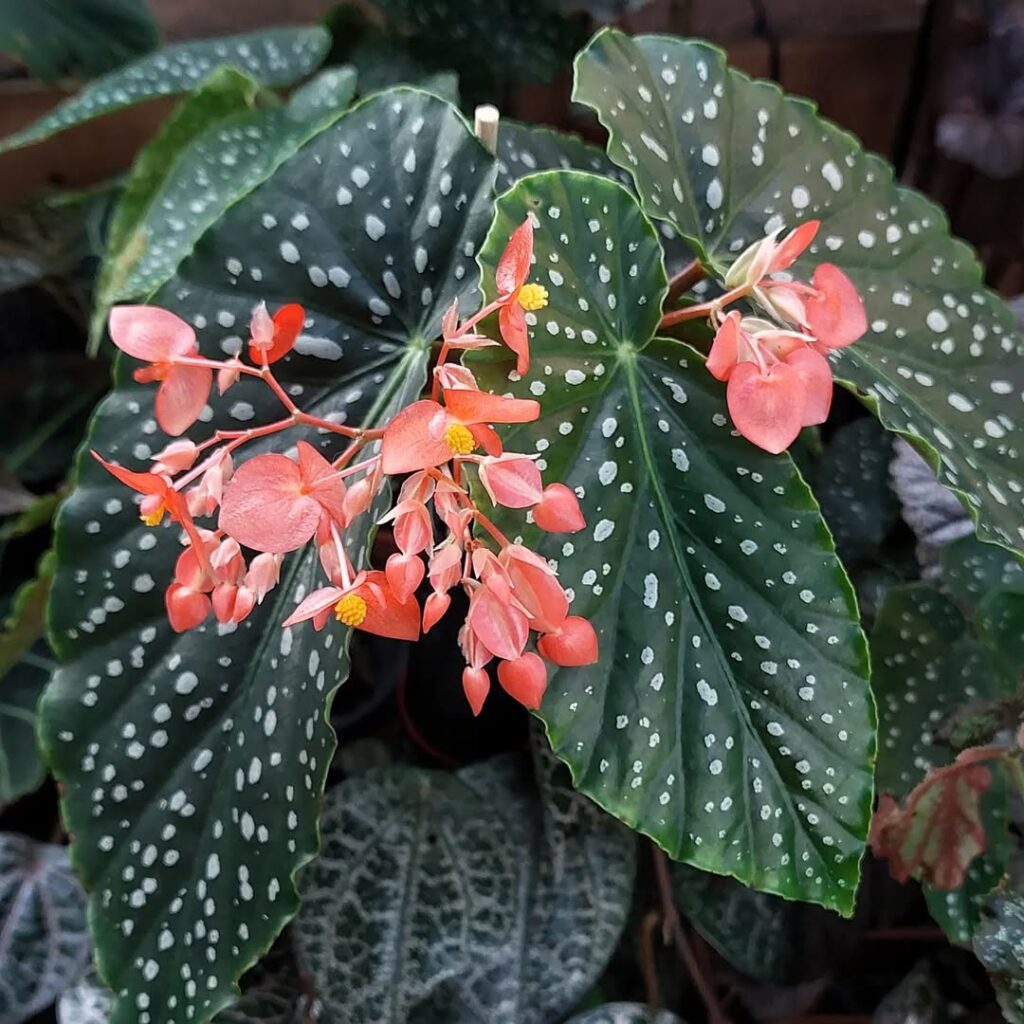
The Begonia’s salmon-pink clusters are eye-catching blooms that appear throughout the year on this popular houseplant. These delicate flowers grow in dense groups atop thick, waxy stems, creating a striking contrast against the plant’s asymmetrical, deep green foliage. The clusters can range from light coral to deep salmon in color, with each individual flower featuring multiple layers of petals that give them a ruffled appearance.
- Light: Bright, indirect sunlight; avoid direct afternoon sun that can scorch leaves
- Water: Keep soil consistently moist but not waterlogged; water when top inch of soil feels dry
- Soil: Well-draining, rich potting mix with high organic matter content
- Humidity: Moderate to high humidity (40-60%)
- Temperature: 65-75°F (18-24°C); protect from cold drafts
- Fertilizer: Feed monthly with balanced liquid fertilizer during growing season
- Container: Use pots with drainage holes to prevent root rot
13. Hydrangea
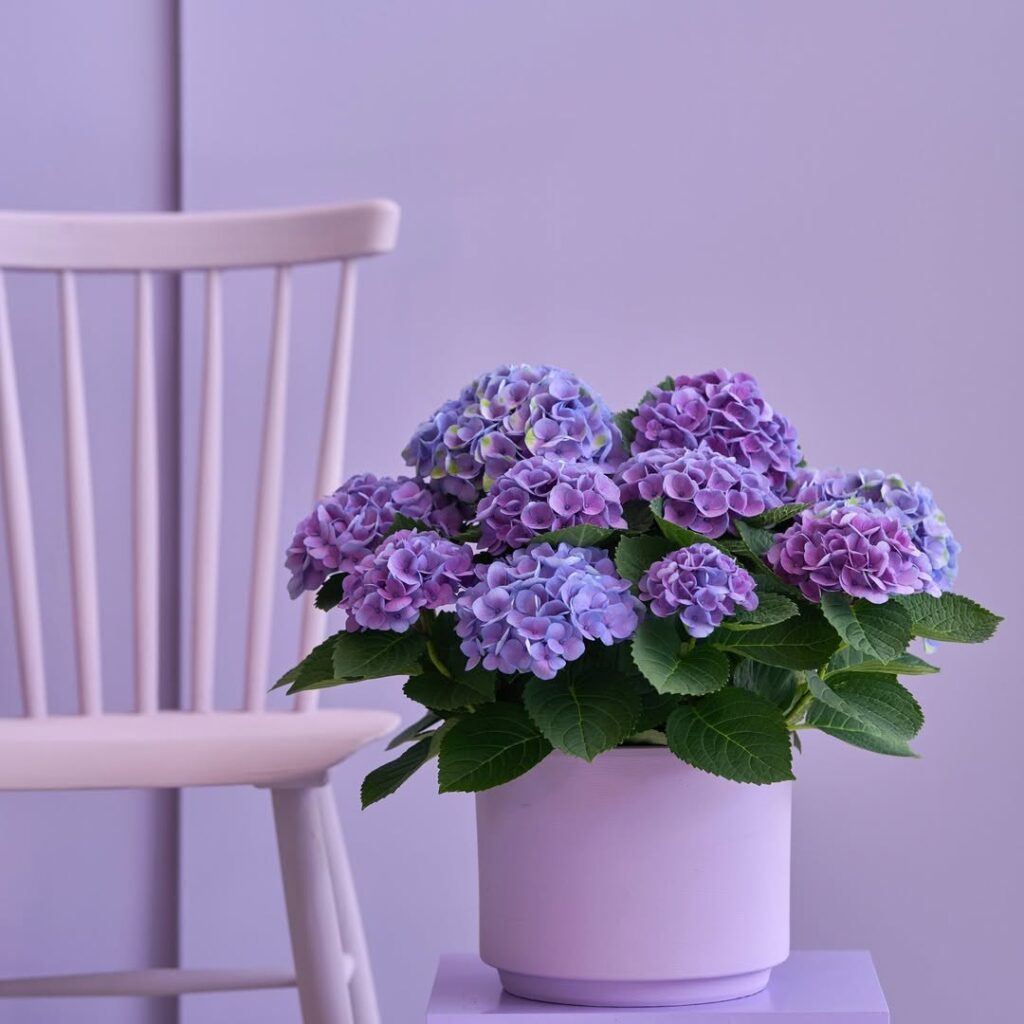
Hydrangeas grown indoors produce stunning spherical flower clusters in shades of gentle blue, creating an elegant focal point in any room. While traditionally outdoor plants, these compact varieties can thrive as houseplants when given proper care, producing their signature globe-shaped blooms throughout much of the year. The blue color intensity depends on soil acidity, with more acidic soil producing deeper blue hues in the delicate, clustered petals.
- Light: Bright, indirect sunlight; morning sun is ideal; protect from harsh afternoon rays
- Water: Consistent moisture; water deeply when top inch of soil feels dry
- Soil: Well-draining, acidic potting mix (pH 5.2-5.5 for blue flowers)
- Humidity: High humidity levels; regular misting or humidity tray recommended
- Temperature: 65-75°F (18-24°C); avoid cold drafts
- Fertilizer: Monthly feeding with balanced, water-soluble fertilizer during growing season
- Container: Large pot with adequate drainage holes
14. Persian Shield

Persian Shield (Strobilanthes dyerianus) features iridescent purple leaves with silvery metallic overtones that appear to shimmer and glow under proper lighting conditions. While not technically a flowering plant, its striking foliage provides year-round color and visual interest as an indoor specimen. The leaves are lance-shaped with deep veining patterns that enhance their metallic appearance, making them a stunning focal point in any indoor garden setting.
- Light: Bright, indirect sunlight; can tolerate some direct morning sun but protect from harsh afternoon rays
- Water: Keep soil consistently moist but not waterlogged; mist regularly to maintain humidity
- Soil: Well-draining, rich potting mix with high organic content
- Temperature: 60-75°F (15-24°C); protect from cold drafts
- Humidity: High humidity levels (50% or higher)
- Fertilizer: Feed monthly during growing season with balanced liquid fertilizer
- Pruning: Pinch back regularly to encourage bushier growth and maintain shape
15. Bromeliad
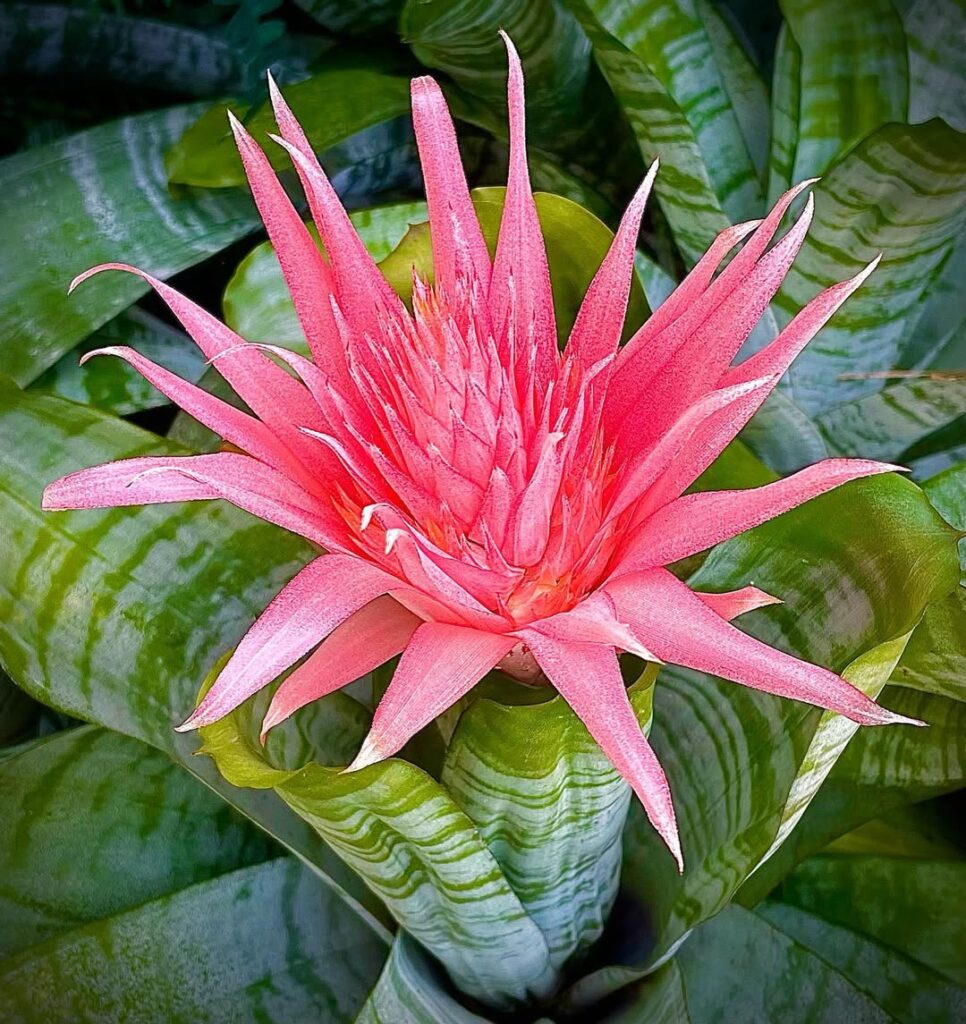
The radiant Bromeliad feature vibrant, torch-like flower spikes in warm orange, yellow, and red hues that emerge from a rosette of stiff, arching leaves. These tropical beauties can bloom for several months, creating stunning focal points in indoor spaces. The flowering bracts maintain their color long after the actual small flowers have faded, providing extended decorative appeal throughout the year.
- Light: Bright, indirect sunlight; avoid direct sun which can scorch leaves
- Water: Keep the central cup filled with water; mist leaves weekly; allow soil to dry slightly between watering
- Soil: Well-draining epiphytic mix or orchid potting medium
- Humidity: High humidity (50-70%)
- Temperature: 65-80°F (18-27°C)
- Fertilizer: Apply diluted balanced fertilizer monthly during growing season
- Container: Small to medium pots with excellent drainage
- Mounting: Can be mounted on bark or driftwood as an alternative to potting
